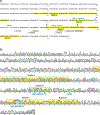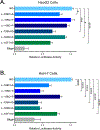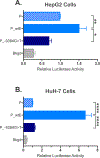Disease-causing mutations in the promoter and enhancer of the ornithine transcarbamylase gene
- PMID: 29282796
- PMCID: PMC7388160
- DOI: 10.1002/humu.23394
Disease-causing mutations in the promoter and enhancer of the ornithine transcarbamylase gene
Abstract
The ornithine transcarbamylase (OTC) gene is on the X chromosome and its product catalyzes the formation of citrulline from ornithine and carbamylphosphate in the urea cycle. About 10%-15% of patients, clinically diagnosed with OTC deficiency (OTCD), lack identifiable mutations in the coding region or splice junctions of the OTC gene on routine molecular testing. We collected DNA from such patients via retrospective review and by prospective enrollment. In nine of 38 subjects (24%), we identified a sequence variant in the OTC regulatory regions. Eight subjects had unique sequence variants in the OTC promoter and one subject had a novel sequence variant in the OTC enhancer. All sequence variants affect positions that are highly conserved in mammalian OTC genes. Functional studies revealed reduced reporter gene expression with all sequence variants. Two sequence variants caused decreased binding of the HNF4 transcription factor to its mutated binding site. Bioinformatic analyses combined with functional assays can be used to identify and authenticate pathogenic sequence variants in regulatory regions of the OTC gene, in other urea cycle disorders or other inborn errors of metabolism.
Keywords: enhancer mutation; gene expression gene regulation; hyperammonemia; ornithine transcarbamylase; ornithine transcarbamylase deficiency; promoter mutation; urea cycle.
© 2017 Wiley Periodicals, Inc.
Figures





References
-
- Balasubramaniam S, Rudduck C, Bennetts B, Peters G, Wilcken B, & Ellaway C (2010). Contiguous gene deletion syndrome in a female with ornithine transcarbamylase deficiency. Mol Genet Metab, 99(1), 34–41. - PubMed
-
- Bolotin E, Schnabl JK, & Sladek FM (2010, August 4, 2010). HNF4A. Transcription Factor Encyclopedia Retrieved from http://www.cisreg.ca/tfe
-
- Breningstall GN (1986). Neurologic syndromes in hyperammonemic disorders. Pediatr Neurol, 2(5), 253–262. - PubMed
-
- Brusilow SW, & Horwich AL (2001). Urea Cycle Enzymes In Scriver CR, Beaudet AL, Sly WS, & Valle D (Eds.), The Metabolic & Molecular Bases of Inherited Disease (Vol. 2, pp. 1909–1963): McGraw-Hill.
Publication types
MeSH terms
Substances
Grants and funding
LinkOut - more resources
Full Text Sources
Other Literature Sources

